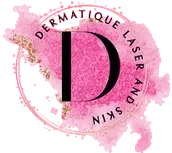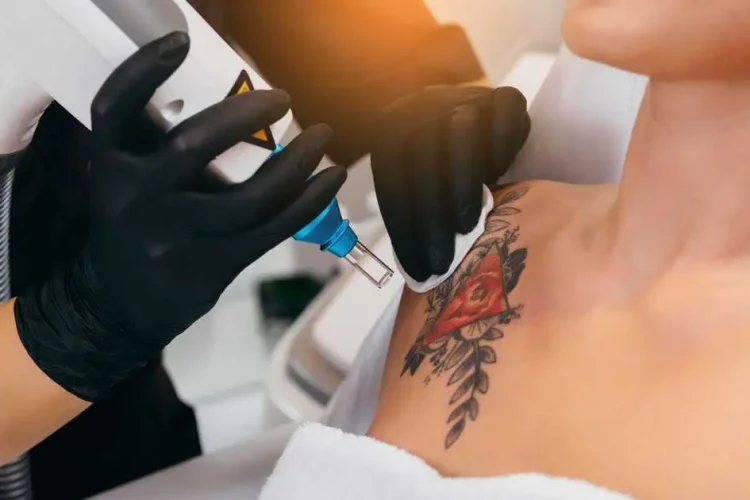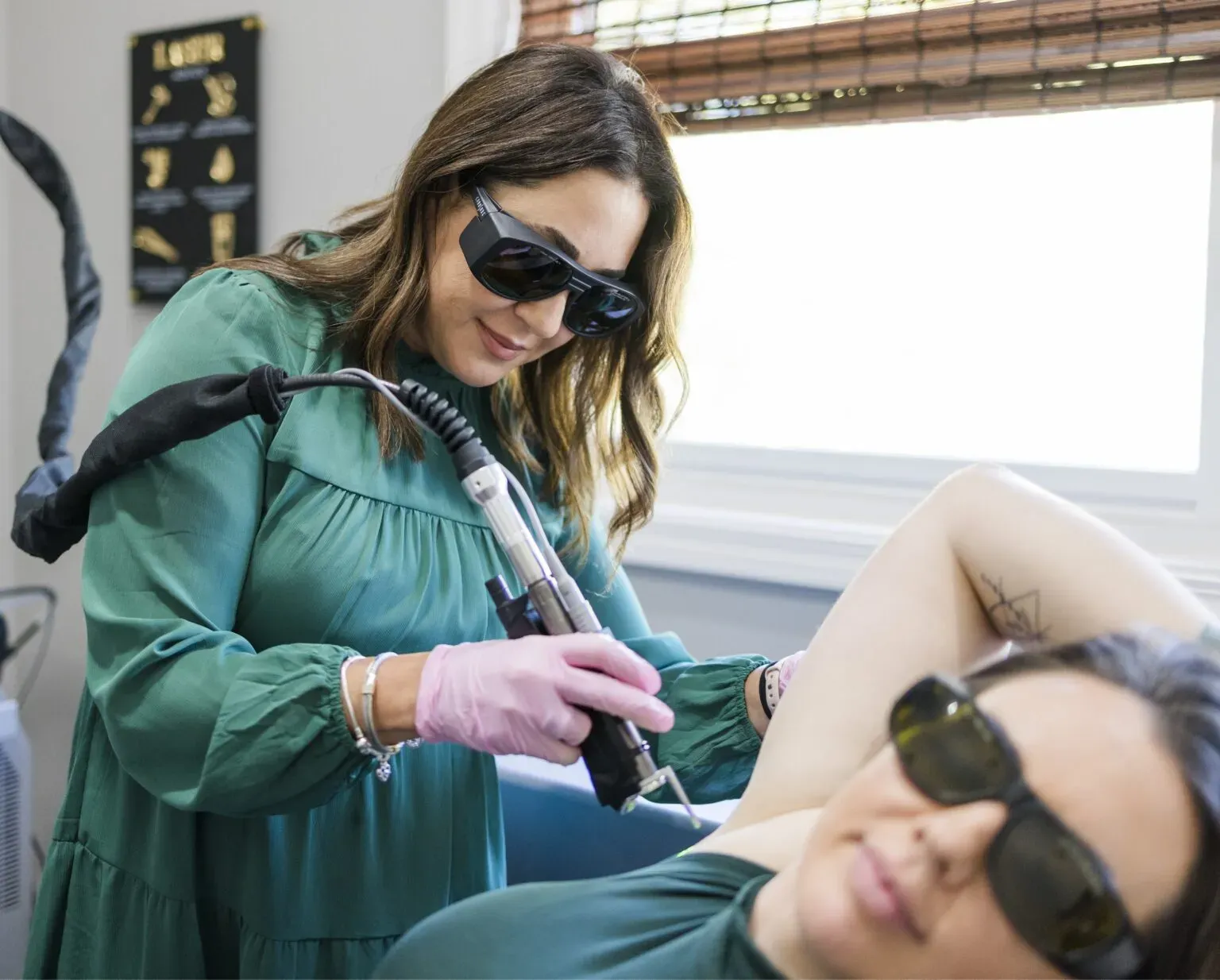Table of Contents
Ink particles are broken down by laser tattoo removal using advanced technology, and it’s specially designed to work effectively on different ink colors and skin tones. At Dermatique Laser and Skin in Geneva, IL, professionals understand that while darker inks like black are more accessible to treat, colors like green and yellow need extra care, using specific laser wavelengths for the best results. That’s why personalized plans and expert care make a real difference. Grab a seat because we’re about to demystify the laser tattoo removal process and what you can expect.
What Exactly Is Laser Tattoo Removal?
Laser tattoo removal isn’t a magic wand that makes ink disappear instantly, but it’s as close as modern technology gets to one. Light beams break down tattoo ink into tiny particles, which are then removed by your immune system. The transformation will take time and effort – time, patience, and a skilled professional.
- Tattoo Removal Using Lasers: Laser tattoo removal for various ink colors uses concentrated light energy to target tattoo pigment. When the laser light hits the ink, it heats the pigment and breaks it into smaller pieces. Over the following weeks, your body’s immune system works, naturally flushing those fragments away. It’s a gradual fade, not a dramatic vanishing act, but each session will bring you one step closer to clearer skin.
- The Types of Lasers Used: Laser tattoo removal uses different technologies to target and break down ink particles. Q-switched lasers are reliable and have been used for years, sending short, intense energy pulses that break up the ink while keeping your skin safe. Pico lasers are a recent innovation, delivering energy even faster to tackle stubborn ink and often needing fewer sessions. The success of tattoo removal varies based on factors like the tattoo’s age, depth, ink density, skin tone, and the colors in the design.
Tattoo Removal for Different Skin Tones
Skin tone plays a significant role in laser tattoo removal. People with lighter skin tones typically have an easier time with the process, while those with darker skin need a more tailored approach.
- Light Skin Tones: Light-skinned individuals generally experience fewer issues with laser tattoo removal because the laser can focus on the ink without much interference from the skin’s melanin. It often leads to faster, more efficient results and a lower chance of skin discoloration, such as post-inflammatory hyperpigmentation or hypopigmentation.
- Medium to Dark Skin Tones: For people with medium to dark skin tones, laser tattoo removal requires extra care because higher melanin levels can compete with the tattoo ink for laser absorption, increasing the risk of skin discoloration. To minimize this, experts often use Nd:YAG lasers, which penetrate deeper and are less likely to interact with melanin. It may take more sessions and a slower, cautious approach to protect the skin, but excellent results are still achievable with a skilled technician.
How Laser Tattoo Removal Handles Different Ink Colors
Tattoos come in a kaleidoscope of colors; each hue reacts differently to laser treatment.
- Black Ink: Black ink absorbs all wavelengths of laser light, making it the easiest color to remove. Most people see significant fading early on with black tattoos, which usually take fewer sessions than multi-colored tattoos.
- Red Ink: Red ink is generally easier to remove than lighter colors, but it can be tricky depending on the shade and depth. Typically, a 532 nm wavelength is used for red pigment, effectively breaking down the color while leaving the surrounding skin intact. Potential Reactions to red ink might experience temporary swelling or redness, but these effects usually subside quickly.
- Blue and Green Inks: Blue and green inks are notoriously stubborn. They reflect more light and require lasers with specific wavelengths, like 694 nm, to break down. If you have vibrant blue or green tattoos, be prepared for a longer journey, as these pigments don’t surrender easily. Pico lasers have significantly improved the treatment of these problematic colors, shattering the particles more efficiently than older laser models.
- Yellow, Orange, and White Ink: These light and reflective colors are the most difficult to remove. The laser has difficulty breaking down these pigments, and complete removal might only sometimes be possible. Sometimes, these colors may require a combination of different laser wavelengths or specialized techniques. While it can be frustrating, a realistic approach and consultation with your laser technician will help manage expectations.
What to Expect During Your Tattoo Removal Sessions
Knowing what to expect can make the experience more comfortable and manageable if you consider professional tattoo removal in Geneva, IL. Here’s a look at how the process unfolds:
- The Initial Consultation: In the first appointment, the esthetic laser specialist will examine your tattoo, discuss your medical history, and assess your skin type. It is your chance to ask questions and get a clear understanding of the journey ahead. The esthetician will outline a treatment plan, including the estimated sessions and potential side effects. They’ll also discuss pre-treatment care, like avoiding sun exposure.
- The Treatment Session: Before the laser gets to work, your skin will be cleaned, and numbing cream may be applied. You’ll also be given protective eyewear. The laser pulses feel like a snapping rubber band or a warm, prickly sensation. While not the most pleasant experience, most sessions are short, lasting between 10 to 30 minutes, depending on the size of your tattoo. Cooling devices or ice packs are often used during and after the session to minimize discomfort and prevent skin damage.
- Aftercare Is Crucial: Your skin might feel like a mild sunburn, with some redness or swelling, but taking care of it properly can make a world of difference. Whenever you see scabs or blisters, gently wash them with mild soap and water. Applying any soothing ointment your technician recommends will help it heal smoothly. Avoid pigmentation problems by protecting your skin – keeping it covered or using sunscreen is vital.
Safety and Side Effects of Laser Tattoo Removal
- Common Side Effects: You might notice some minor skin irritation, like a mild sunburn, but don’t worry—it usually fades within a few days. Blistering can happen and is normal; it’s just your immune system removing the ink. Sometimes, you might see temporary skin discoloration, like slightly darker or lighter areas, but this typically goes away as your skin matures.
- Special Considerations for Different Skin Tones: Darker skin tones are more prone to temporary darkening of the treated area. Conversely, lighter patches may appear if the laser affects the skin’s melanin.
- Tips for Minimizing Risk: To minimize risk, carefully follow your aftercare instructions, shield the treated area from sun exposure, and work with an experienced laser technician who understands how different skin tones and ink colors react to treatment.
Consult a Professional
Laser tattoo removal takes time, but the results can be excellent. Knowing how your skin tone and ink colors influence the process is essential, whether you’re getting a simple black design or a colorful sleeve. Contact us today to schedule a self assessment and let our experienced medical esthetic laser specialist guide you on the best tattoo removal treatment option.
Takeaway
Enjoy clear, confident skin with help from Dr. Gina Lesnik and her skilled team at Dermatique Laser and Skin. Dr. Lesnik’s genuine care and expertise create a welcoming environment where comfort comes first. If you’re ready to say goodbye to unwanted ink and embrace a fresh start, they’re here to guide you every step of the way. Book your consultation today!







